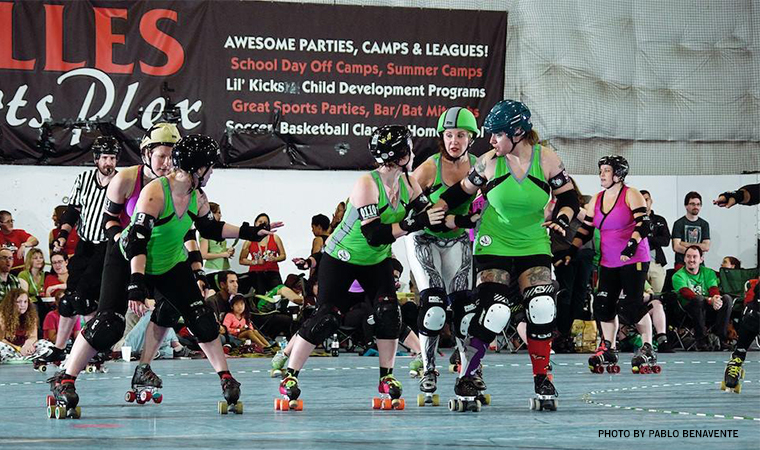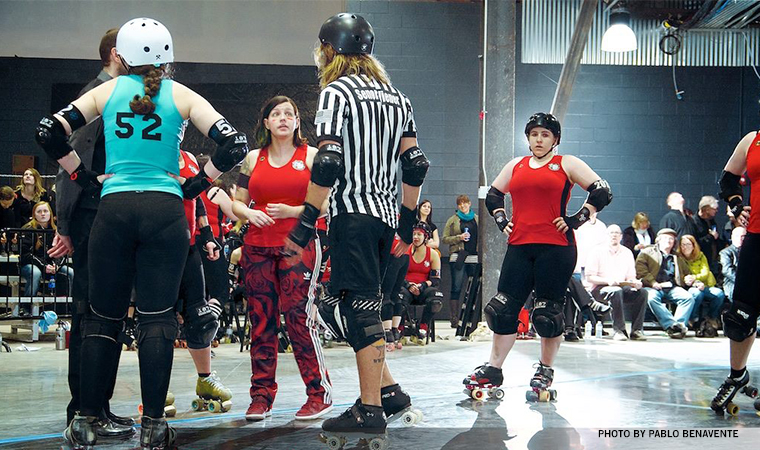
A major competitive sporting event is happening this weekend, and there’s a good chance you haven’t heard about it. It won’t draw the huge crowds of the World Series, yet it’s one of the fastest-growing sports in the world: the Women’s Flat Track Roller Derby championship.
What does this have to do with public relations? A lot, as it turns out. In roller derby, you score points by lapping members of the opposing team. In the course of this, there’s a good chance you’ll get knocked down. In fact, your statistical chances of not falling during a game are slim. And when you do fall, it’s critical to get right back up, or risk falling behind.
Are you beginning to see the parallels between roller derby and public relations?
I started playing roller derby in 2007 as an outlet for my tendency to lean toward perfectionism. But I had no idea it would help me in so many other ways, particularly in my work as a public relations professional. Here are three lessons in particular that totally transformed my approach to my work and career in public relations.
Lessons from the Track
I learned the value of studying film—the good and the bad.
Any athlete will tell you, studying game footage is an integral piece of his/her preparation for game day. But watching yourself at your best only presents a small piece of the puzzle. Athletes and public relations professionals can often narrowly focus on “wins” and the metrics that demonstrate their team’s success.
It is critical to watch yourself from all sides for a complete picture of your performance. As painful as evaluating a blowout game or a new business loss can be, it forces you to strip away the emotions felt in the moment and hone in on the game plan. You can look for patterns, inefficiencies and opportunities for improvement.
I learned don’t just watch yourself. Watch everyone.
Women’s flat track roller derby involves a wide range of teams. There are dominant national teams, smaller independent teams who move fluidly within rankings and teams well versed in multiple rule sets and styles. Evaluating what others are doing well or not so well, even when they are not direct competition, can trigger new ideas for approaching common goals and objectives.
I learned that teams function best when individual strengths complement rather than compete with each other.
As a roller derby coach, it was my job to help select the skater line ups to be used in a game. It was not as easy as “putting your best with your best.” One season, four of my best skaters when sent on the track together had a tendency to play as individuals, rather than as a unit. I knew in order to be successful, I had to pair them with skaters who would stay with their unit and act as anchors. We also varied the roles of skaters from line up to line up, depending upon what was needed on the floor. If we needed more offensive help, I might play a skater more with those particular skills versus defensive heavy skaters.
Balancing your lineup is critical in building a communications team or working with colleagues outside of your team. Don’t just bring your four best strategic minds to the table and call it a day. Make sure you have a mix of strategic thinkers and tacticians ready to work as a unit and compliment each other’s strengths. Your line up may expand and contract based on needs for specialized skills such as social media, content marketing or public affairs.
I learned how to deal with success…and with failure. I realized that you can’t dwell too long on either because you need to be ready for another one around the corner.
The roller derby is broken down into “jams” that can last anywhere from thirty seconds to two minutes. At most, you get a jam or two off to collect your head and sometimes you play back to back. The best teams have what we call “jam-nesia.” They know each time the clock resets it is a new opportunity. They don’t get lost in a fog of self doubt nor do they become complacent in their victories.
How many times have you had a pitch go unanswered to the point where you began dissecting every word choice until you were left with just “Hello”? The structure of roller derby and public relations means your next challenge is just moments away so there’s no time to dwell on success or failure for too long. You take the most obvious lessons, apply them to the next opportunity and execute again.
Want to know more about roller derby?
On November 6, the top women’s flat track roller derby teams in the world will compete for a chance to take home the international title known as the Hydra. You can watch the first two days live on WFTDA.tv. Day three will be shown exclusively on ESPN3 in the United States, and on WFTDA.tv everywhere else.
Ashley recently joined the Stanton Communications team. Previously, she spent 10 years working in-house in trade associations and eight years playing and coaching women’s flat track roller derby in Washington, D.C. and Baltimore.
